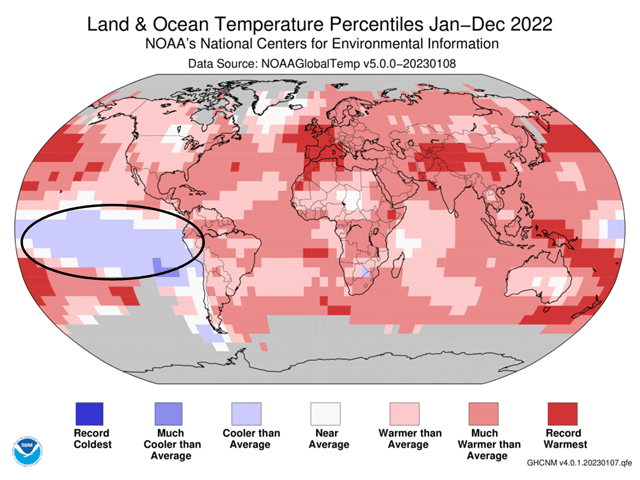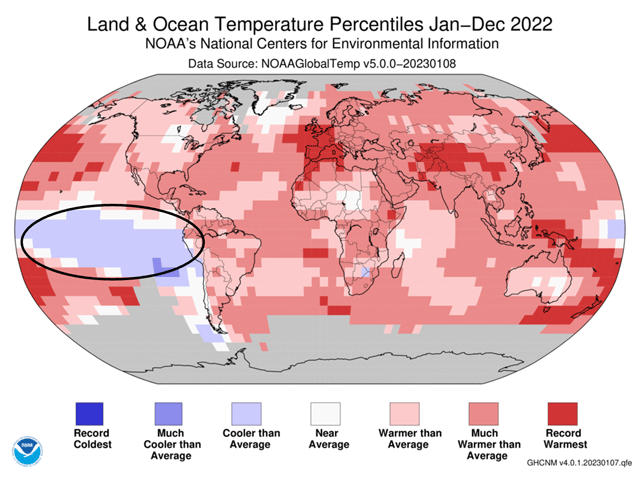Ag Weather Forum
World Warmth Continued in 2022
The plateau of global warmth in the past 10 years showed up again in 2022. The annual global temperature report from the U.S. National Oceanic and Atmospheric Administration National Centers for Environmental Information (NOAA/NCEI) leads with this observation:
"The year 2022 was the sixth warmest year since global records began in 1880 at 0.86 degrees Celsius (1.55 degrees Fahrenheit) above the 20th century average of 13.9 degrees C (57.0 degrees F). This value is 0.13 degrees C (0.23 degrees F) less than the record set in 2016 and it is only 0.02 degrees Celsius (0.04 degrees Fahrenheit) higher than the last year's (2021) value, which now ranks as the seventh highest. The 10 warmest years in the 143-year record have all occurred since 2010, with the last nine years (2014-2022) ranking as the nine warmest years on record. Of note, the year 2005, which was the first year to set a new global temperature record in the 21st century, currently ties with 2013 as the 11th-warmest year on record. The year 2010, which had surpassed 2005 at the time, now ranks as the 10th-warmest year on record."
The past two years, 2021 and 2022, are in the top 10 for record warmth despite a multi-year La Nina being in effect. The NOAA/NCEI report notes that along with a detail about regional annual record warm temperatures in some very important global regions:
"The year was characterized by much-warmer-than-average temperatures across much of the globe, with record-high annual temperatures across parts of Europe, southern Asia, the North and southwestern Pacific Ocean, the Atlantic, and southeastern Pacific oceans. Meanwhile, cooler-than-average temperatures were limited to the central and eastern tropical Pacific Ocean, consistent with an episode of La Nina that persisted throughout the year."
P[L1] D[0x0] M[300x250] OOP[F] ADUNIT[] T[]
Extreme heat events are referred to often in this report. They include an intense January heat wave in Argentina which lasted for three full weeks; the first recorded occurrence of temperatures above 104 F in the United Kingdom; the highest yearly temperature in Ireland since 1900; the warmest year in Spain's 62 years of recordkeeping; the third-warmest year in the Netherlands and in Austria; the warmest year in France's 123 years of recordkeeping; and the earliest-ever recorded heat wave in the Spanish islands off the Iberian Peninsula.
In Africa, every month was warmer than average. Asia temperatures were second warmest on record, including scorching heat waves in India, Pakistan and Japan. The annual temperature in Asia was more than 3 degrees F above the long-term average. Australia had the 22nd-warmest year on record (since 1910) with the annual temperature at 0.9 degrees F above the 1961-1990 average.
Antarctica temperatures were extraordinarily high. During mid-March 2022, temperatures were at least 40 degrees Fahrenheit above average. News media reports featured new record warm readings at several stations. For example, the Concordia station had a temperature of minus 12.2 C (10 F), which is 38.8 degrees C (70 deg F) above average. (The Concordia station is located on Dome C on the Antarctic Plateau.)
For world temperatures, the last year with annual temperatures below the long-term average was back in 1976. And, even a multi-year La Nina was only effective in bringing cooler conditions to the central and eastern Pacific Ocean. La Nina may have reduced the extent of warming globally, but it did not reverse the long-term trend.
The full report is available at this link: https://www.ncei.noaa.gov/…
Bryce Anderson can be reached at Bryce.Anderson@dtn.com
Follow him on Twitter @BAndersonDTN
(c) Copyright 2023 DTN, LLC. All rights reserved.






Comments
To comment, please Log In or Join our Community .